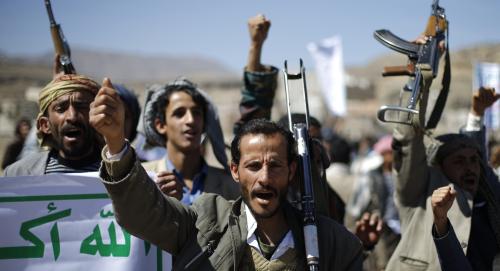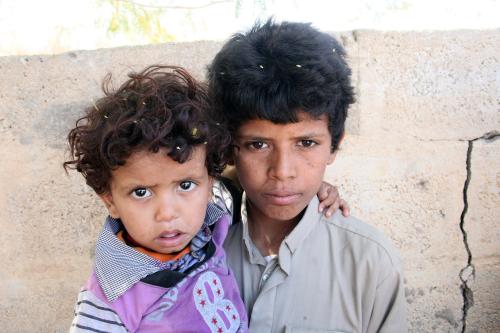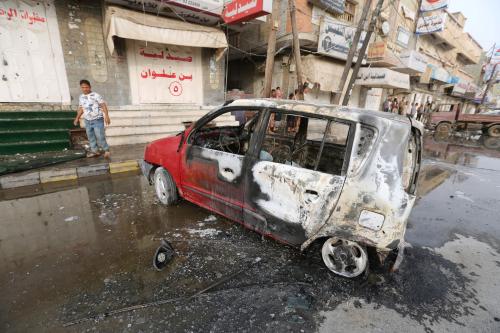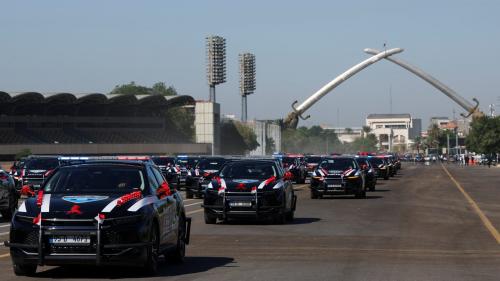The sudden intervention by 10 countries in Yemen’s civil war is probably confusing to most Americans. Indeed, Mark Twain supposedly held that “God created war so that Americans could learn geography.” At Brookings, we have elevated this insight to a business model. Our theory is that if our fellows maintain enough expertise on apparently obscure countries, we’ll be ready when wars break out in them to educate a suddenly interested public. Lately (and unfortunately) this theory has really been working out for us.
So today’s lesson is on Yemen, which we are reliably informed by Brookings’s Center for Middle East Policy, is a country in the Middle East. It also apparently has a long history of civil conflict, its main export is petroleum, and it may or may not be vital to U.S. interests. And true to our mission, it turns out that various Brookings scholars have been beavering away on this topic for some time, just waiting for the day when you, our dear reader, would, through the clarifying lens of war, finally see that you should learn about the place. Jennifer Williams, a research assistant in the Center for Middle East Policy, has helpfully gathered much of their recent work on Yemen in a post on the Markaz blog.
Several important insights emerge from their collective work that help contextualize the developments of the last couple of days:
- The United States is already fairly deeply involved in Yemen, regardless of whether the U.S. public has been paying attention. For several years, the United States has been fighting a quiet war there with the cooperation of the Yemeni government, mostly using drones and special forces, against al-Qaida in the Arabian Peninsula (AQAP). Many counterterrorism officials see AQAP as a uniquely dangerous terrorist group from a U.S. perspective because it has demonstrated both the will and the capacity to attack U.S. targets. Brookings Senior Fellow Dan Byman wrote a controversial Foreign Affairs piece in 2013 arguing that such U.S. counterterrorism efforts were effective. Many other experts, however, including Ibrahim Sharqieh, deputy director of Brookings Doha Center, have questioned whether those efforts have been effective and whether they have rather contributed to Yemen’s instability. The recent collapse of the government under the onslaught of the Houthis (an Iranian-backed Shi’ite militia that also dislikes AQAP) at least suggests they may have a point.
- Yemen is located very near, indeed right next to, Saudi Arabia and that matters a great deal. For reasons of history and geography, the Saudis are deeply interested, indeed arguably obsessed, with developments in Yemen. It is simply impossible for them to stand aside while an Iranian-backed militia takes over in Yemen. Senior Fellows Ken Pollack and Bruce Riedel have been making this point in various forums for several months. Riedel has particularly noted that the new King of Saudi Arabia intended to make Yemen his first priority.
The Saudi interest engages the United States with Yemen on a level well beyond counterterrorism. Saudi Arabia is far and away America’s most important Arab ally left standing. Its critical role in the global energy market as well as its cooperation with the United States in the dual struggle against both Iran and the Islamic State (ISIS) mean that the United States cares deeply about what happens to Saudi Arabia. Indeed, in part for these reasons, Martin Indyk suggested in an “Order from Chaos” blog post that the United States should commit in an even deeper way to its alliance with Saudi Arabia.
Following this logic, Ken Pollack argues in a brilliant and provocative piece on the “Markaz” blog this morning that Saudi Arabia’s intervention in Yemen is ill-conceived and very likely to seriously weaken the already fragile Saudi monarchy. He suggests that the only good reason for the United States to get involved in the Yemen intervention is to monitor Saudi efforts and restrain Saudi Arabia’s worst instincts.
These various observations bring us back full circle to the question of whether U.S. vital interests are engaged by the Saudi-led intervention in Yemen. The incident as a whole demonstrates, if any demonstration was necessary, that in the Middle East everything is logically and intimately related to everything else. So by defining any part of the Middle East as a vital interest, the United States has effectively conceded that every obscure corner is.
This wasn’t so bad when those obscure corners had the good grace to stay stable—or at the very least only explode one at time. Today with Syria, Iraq, Libya, Yemen, Lebanon, and maybe in the not too distant future Tunisia or Saudi Arabia swirling into instability, it is perhaps time to consider whether the concept of U.S. “vital interests” in the Middle East has been stretched beyond its capabilities to protect them.
(Postscript: The 10 countries involved in the intervention in Yemen are: Saudi Arabia, Bahrain, Qatar, Kuwait, UAE, Egypt, Jordan, Morocco, Sudan, and Pakistan. Previous wars in the region mean that you should be able to locate nearly all of these countries on a map.)
The Brookings Institution is committed to quality, independence, and impact.
We are supported by a diverse array of funders. In line with our values and policies, each Brookings publication represents the sole views of its author(s).







Commentary
Why are 10 countries attacking Yemen?
March 26, 2015